
Cisticolas are a genus of very small insectivorous birds formerly classified in the Old World warbler family Sylviidae, but now usually considered to be in the separate family Cisticolidae, along with other southern warbler genera. They are believed to be quite closely related to the swallows and martins, the bulbuls and the white-eyes. The genus contains about 50 species, of which only two are not found in Africa: one in Madagascar and the other from Asia to Australasia. They are also sometimes called fantail-warblers due to their habit of conspicuously flicking their tails, or tailor-birds because of their nests.
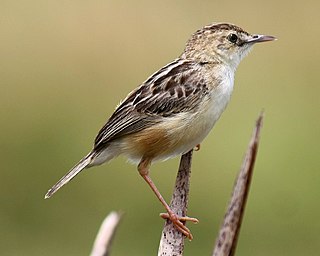
The zitting cisticola or streaked fantail warbler is a widely distributed Old World warbler whose breeding range includes southern Europe, Africa, and southern Asia down to northern Australia. A small bird found mainly in grasslands, it is best identified by its rufous rump; as well, it lacks any gold on the collar and the brownish tail is tipped with white. During the breeding season, males have a zigzagging flight display accompanied by regular "zitting" calls that have been likened to repeated snips of a scissor. They build their pouch nest suspended within a clump of grass.

The tiger shrike or thick-billed shrike is a small passerine bird which belongs to the genus Lanius in the shrike family, Laniidae. It is found in wooded habitats across eastern Asia. It is a shy, often solitary bird which is less conspicuous than most other shrikes. Like other shrikes it is predatory, feeding on small animals. Its nest is built in a tree and three to six eggs are laid.

The capped wheatear is a small insectivorous passerine bird that was formerly classed as a member of the thrush family Turdidae, but is now more generally considered to be an Old World flycatcher, Muscicapidae.
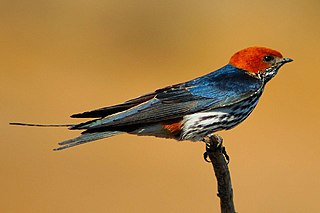
The lesser striped swallow is a large swallow. It breeds in Sub-Saharan Africa from Sierra Leone and southern Sudan south into eastern South Africa. It is partially migratory with South African birds wintering further north. West African birds leave the north of the breeding range in the dry season.

The southern masked weaver, or African masked weaver, is a resident breeding bird species common throughout southern Africa.

The Karoo prinia or spotted prinia is a small passerine bird. It is a resident breeder in South Africa, Lesotho and far southern Namibia.

The Drakensberg prinia or saffron-breasted prinia is a small passerine bird. It lives in eastern South Africa and Eswatini.
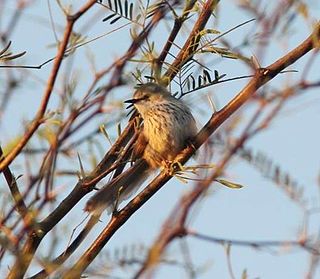
The Namaqua warbler, also known as the Namaqua prinia or white-breasted prinia, is a small passerine bird, a cisticolid warbler and the sole member of the genus Phragmacia. It was formerly placed in the genus Prinia, but was found to be sufficiently distinct to warrant a genus of its own.

The neddicky, or piping cisticola, is a small passerine bird in the family Cisticolidae, which is native to Africa, southwards of the equator. Its strongholds are the light woodlands and shrublands of the subtropics and temperate regions of southern Africa. The common name, neddicky, is the Afrikaans name for the species.
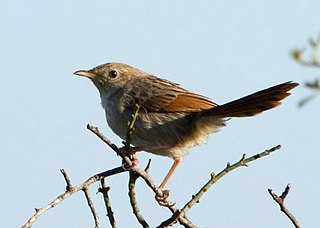
The grey-backed cisticola or red-headed cisticola is a small passerine bird. This cisticola is a resident breeder in southernmost Angola, Namibia and western South Africa.

The tractrac chat is a small passerine bird of the Old World flycatcher family Muscicapidae. It is a common resident breeder in southernmost Angola, western Namibia and western South Africa.
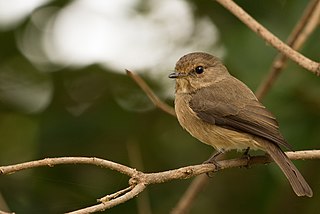
The African dusky flycatcher, dusky-brown flycatcher or dusky alseonax, is a small passerine bird of the Old World flycatcher family, Muscicapidae. It is a resident breeder in Africa from Nigeria, the Central African Republic, South Sudan and Ethiopia south to South Africa. It is very common in its woodland habitat, which includes riverine forests, evergreen forest edges and clearings, especially near water bodies such as lakes, dams and streams, and well-wooded suburban gardens.

The lesser swamp warbler or Cape reed warbler is an Old World warbler in the genus Acrocephalus. It is a resident breeder in Africa from the Democratic Republic of the Congo, the Chad and Ethiopia south to South Africa. This is a common species of reedbeds in standing water.

The Cape grassbird or Cape grass warbler is an African warbler found in southern Africa.
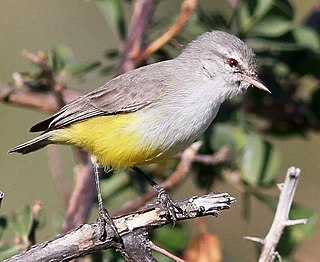
The yellow-bellied eremomela is an Old World warbler. However, the taxonomy of the "African warblers", an assemblage of usually species-poor and apparently rather ancient "odd warblers" from Africa is currently in a state of flux. Today, most taxonomists consider members in this genus members of the family Cisticolidae.

The African snipe also known as the Ethiopian snipe, is a small stocky wader. It breeds in eastern and southern Africa in wet mountain moorland and swamps at altitudes of 1,700–4,000 m (5,600–13,100 ft). When not breeding it disperses widely, including into coastal lowlands.
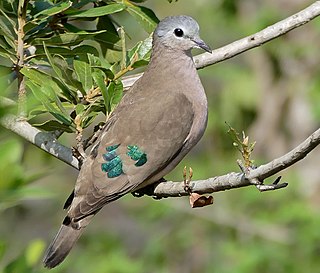
The emerald-spotted wood dove is a bird of the family Columbidae, resident across eastern and southern Africa. It is a species of open drier deciduous woodland and second growth. It is absent from evergreen rainforests and semidesert areas.
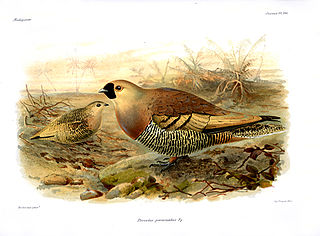
The Madagascar sandgrouse is a species of bird in the family Pteroclidae. It is endemic to Madagascar and is a ground-dwelling short-legged plump bird. The head of the male is brown with a black area surrounding the beak. It has a pinkish-buff coloured breast, a light brown mottled back, brown wings and paler underparts barred with dark brown. The female has a generally duller appearance being cryptically coloured brown with dark specks and bars.
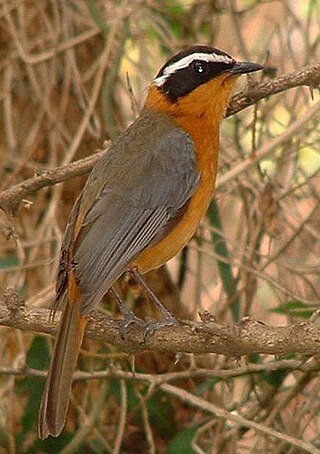
The white-browed robin-chat, also known as Heuglin's robin, is a species of bird in the family Muscicapidae. Found in east, central and southern Africa, its natural habitats include riverine forest and thickets, and it is also found near humans. The IUCN classifies it as a least-concern species.






















